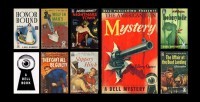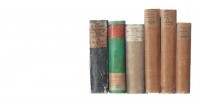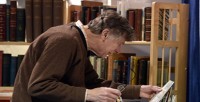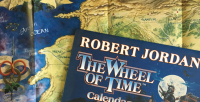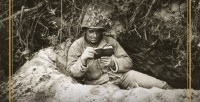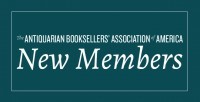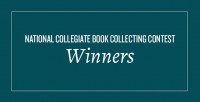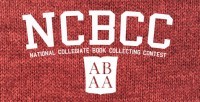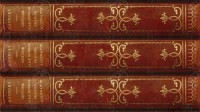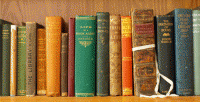One phrase you might hear at a rare-book fair is mapbacks. No, that's not some sort of tattoo favored by rare map dealers; a "mapback" is the informal name for a series of pulp paperback books published by Dell between 1943 and 1950. Initially, the back cover of these books featured bland art, but starting with the fifth book in the series, Four Frightened Women by George Harmon Coxe, Dell added an illustration showing the locale where the book's events took place. (Note: the previous book in the series, The American Gun Mystery by Ellery Queen, was later reprinted with a map on the back cover, but it was the fifth book in the series that was the first to feature a map.) The “maps” were not all conventional maps by any means, with cut-away illustrations of buildings being a frequent option the various artists used when the action was largely confined to one house or building. Dell paperbacks were distinguished airbrushed art and a distinctive Keyhole collophon with an eye peering through, a nod to the lurid mysteries they mainly published in the paperback line — although they soon began to add thrillers, romance, western titles, even historical novels and nonfiction as the series grew in popularity. The keyhole logo soon accreted a number of variations to denote genre, and (according to Piet Schreuders in The Book of Paperbacks) in 1949 it ceased to be used on the rear of mapbacks). Curtains for the Copper by Thomas Polsky New York: Dell Publishing Company. First editio... [more Collecting Dell Mapbacks]
frontpage-carousel
Research documenting rare bindery dust jackets from the eighteenth to the twentieth centuries. Adapted from the Spring 2019 Journal of The Private Libraries Association, Pinner, Middlesex, England. Reprinted by permission. The practice of issuing dust jackets on new books is generally thought to have begun with the introduction of publishers' bindings around 1820. Books issued before then (and after) in provisional bindings are believed to have neither needed nor received jackets.1 But while this understanding of early jacket use has long seemed correct for British, American and European books, recently examined evidence shows that dust jackets were issued long before the 1820s in the German states and probably elsewhere in Europe. Most of the surviving examples of these jackets, including the earliest ones, are of German origin, which is where this previously undocumented and all but unknown chapter of book history begins. I. Two-piece bindery jackets 1760s–1860s Throughout the latter decades of the eighteenth century and beyond, German binderies produced a distinctive and durable type of dust jacket for the simple board bindings of that period. This practice continued well into the era of publishers' bindings in the nineteenth century. Examples of these jackets have been examined on about thirty titles, all bound in paper-covered boards, from the 1760s to the 1860s.2 These early jackets had several characteristics that were common to them throughout the entire period of t... [more Early Bindery Dust Jackets]
Wouldn't you like to automate the process of searching our members' listings for the books or other items you desire? Well, you can easily let us do the searching for you! WANT LISTS Customers can set up “Want Lists” — saved searches for the books or items you are actively hunting for — which alert you (by email) anytime a new copy is listed or an existing listing changes substantially (new price, image added, etc.). You can tailor the frequency of these emails to suit your needs: Daily emails let you know within hours of any change or new copy being listed. Weekly or monthly emails will send you a digest of all new titles listed in the preceding week or month (and not sold by the time the email is sent). The default setting is for daily emails (as that's what ABAA members prefer). If you're actively trying to collect a popular niche or subject area, you may want more frequent emails, so no other collector beats you to your prize. CREATING A SAVED SEARCH "Want List" searches can be as general or specific as you wish. You can search for any books by a particular author, or just first editions, with or without dust jackets, or a very specific edition within a certain price range, etc., etc. If you want to monitor new listings in a broad category, enter the salient information in the “Keyword” field. (Ex: "Anarchy" or "Poetry, Ireland"). Once you've set up the search parameters, you can sit back and relax in the knowledge that if a book you want is offered for sale o... [more Let Us Do the Rare Book Searching for You!]
Robert Jordan was the best-selling author of The Wheel of Time fantasy series, and (because I need to get my utter impartiality out of the way at the start) one of my favorite authors. I've collected his books for the past 25 years. If you're unfamiliar with The Wheel of Time, think of it as a 14-volume The Lord of the Rings set at a future point in Earth's history when society has regressed technologically and forgotten most of our history -- but discovered magic, naturally! Total sales for the series are estimated to be in excess of 80 million copies, although those figures are several years old and at least one of his publishers has suggested the estimate is on the low side. With a total readership of that magnitude, it seems likely there are many people collecting Jordan's books and related items, so we have assembled this guide to the major works and significant associated items. Jordan's real name was James Oliver Rigney, Jr., a Vietnam veteran who later worked for the US Navy as a nuclear physicist. Rigney began writing for his own amusement in 1977, and published under several pseudonyms in the 1980s. The first book of The Wheel of Time (WoT) series, The Eye of the World, was published in 1990, and sold well. By 1993, when the fifth installment, The Fires of Heaven came out, WoT books were huge bestsellers. Rigney was diagnosed with amyloidosis in 2006, and died in September 2007 after undergoing extensive medical treatment at the Mayo Clinic. After his death, one of ... [more Collecting Robert Jordan’s Wheel of Time]
Armed Services Editions, small-format paperback books distributed to US servicemen during WWII, are credited with achieving a great deal: not just with improving morale among the troops, but also with revolutionizing the post-war publishing industry, making certain books into classics, and expanding the American middle class. The book When Books Went to War: The Stories That Helped Us Win WWII, by Molly Guptill Manning, reveals the largely forgotten story of the Armed Services Editions. When the US entered the war after Pearl Harbor, librarians initially got behind a nationwide book drive, the Victory Book Campaign, which aimed to collect 10 million donated books and supply them to the troops. Although this campaign was eventually successful, it took time, and many of the donated books were too old or heavy to be of use. A group of publishers came together to form the Council on Books in Wartime, and resolved to produce a series of lightweight, durable books which reprinted popular novels and classics that would be of interest to the soldiers, sailors, and airmen serving their country. The format was innovative: paperback, stapled (later glued) on the short side, and printed in small type across two columns to fit more words on a page and make reading under battlefield conditions easier. The covers were thumbnails of the original hardcover jacket image, and carried lists of the other ASE titles released that month. The books were initially printed in two sizes, both designed ... [more Collecting Armed Services Editions]
Meet the latest antiquarian booksellers accepted as members of the ABAA. Full Members: Keith de Lellis, Keith de Lellis Gallery LLC, New York City, NY Beginning in 1970 at the age of 15, Keith de Lellis began dealing in Fine Art Photography and has done so continuously over the past 50 years. De Lellis has watched the interest in photographs grow from an exceedingly small specialized market into a major field of collecting. He started dealing when he was in junior high school and was soon selling to the Smithsonian, the Metropolitan Museum of Art along with collectors some of whom are long forgotten others who are now legends to those familiar with some of the early figures in the world of collecting art photography. The first thirty years operating as a private dealer in Manhattan and beginning in 1998 as gallery owner of the Keith de Lellis Gallery in three locations on the upper east side. First in a beaux arts mansion at 47 East 68th Street for 10 years and next at 1045 Madison Avenue for 7 years and for the past three years in the Fuller Building at 41 East 57th Street. De Lellis is known as a canny dealer who spots trends in collecting and undervalued artists before they become mainstream and popular among collectors and museums. The gallery presents five exhibitions a year. Richard Erdmann, Mare Booksellers, Dover, NH Richard Erdmann began selling books, informally, in 2001, as a way to build his personal collection; but by 2007 he transitioned to selling books as a fu... [more New Members of the ABAA]
We asked the winners of the 2021 National Collegiate Book Collecting Contest to introduce themselves, and learned about some fascinating books and collections along the way! First place: Jessica Camille Jordan (Stanford University): Could you give us a brief description of your collection? My collection is comprised of works that bear the illustrative or graphic design work of husband/wife duo Leo and Diane Dillon, whose career together spanned six decades. Most of the objects in my collection are books, but there are also comics, records, posters, and more. The earliest items I have are science fiction pulp magazines from the 1950s, and the most recent is a 2019 picture book called Love and the Rocking Chair, an autobiographical story they were working on at the time of Leo's death in 2012, and which Diane later completed. What first interested you in Leo & Diane Dillon? Although I didn't know it at the time, their artwork graced some of my favorite books as a young reader, including Wise Child by Monica Furlong and Sabriel by Garth Nix. Later on, I learned more about their fascinating lives and career, and I felt it was important to try and create a comprehensive bibliography of their work. But I have always been really drawn to and moved by the beauty of their art, and that's where the initial interest came from. What currently has pride of place in your collection? Probably the Reader's Digest Condensed Books installment that contains their illustrations for a condensed v... [more Meet the 2021 NCBCC Winners]
The ABAA is proud to announce the winners of the 2021 National Collegiate Book Collecting Contest. First: Jessica Camille Jordan (Stanford University) for "Six Decades of Leo and Diane Dillon." Second: Read W. Brown (New York University) for "The Serious Business of Fun: A Collection of Books on the Video Game Industry." Third: Shannon D. Bohle (Johns Hopkins) for "Life through Space and Time: A Personal Journey through Modern Science, Collecting Hand-signed Autographs, Manuscripts, and First Editions." Essay Award Joseph E. Hiller (Duke University) for his essay "Como un detective salvaje: Gathering Small Press, Experimental, and Untranslated Latin American Literature." The National Collegiate Book Collecting Contest is jointly administered by the Antiquarian Booksellers' Association of America (ABAA), the Fellowship of American Bibliophilic Societies (FABS), the Grolier Club, and the Center for the Book and the Rare Books and Special Collections Division (the Library of Congress) Congratulations to all the winners of the 2021 National Collegiate Book Collecting Competition! [more 2021 NCBCC Winners]
The Kenneth W. Rendell Collection on the Detection of Forged Handwriting Donated to the Grolier Club. The Grolier Club Library is pleased to announce the receipt of a major gift, the Collection on the Detection of Forged Handwriting, which is the most important and comprehensive collection on the subject known to exist anywhere. The gift is from club members Kenneth W. Rendell and Shirley McNerney. Rendell, a leading dealer in historical letters and documents, has exposed numerous famous forgeries such as the Hitler Diaries fraud, Mussolini's diaries, the Mormon forgeries and murders, and Jack the Ripper's forged diary. This collection was formed over a 60-year period and consists of thousands of forgeries, facsimiles of handwriting, reference books, and archival files concerning major cases in which Rendell has been involved. The collection is wide-ranging, encompassing historical letters and manuscripts from the early 17th century to the modern day. Classic forgeries of Shakespeare, Robert Burns, Schiller, Washington, Lincoln, Franklin, Berlioz, Wagner, Poe and numerous others are included. Rendell made every effort over his long and distinguished career to acquire original examples of past forgers from many sources, including the files of dealers such as Charles Hamilton, Mary Benjamin and Goodspeeds. The gathering together of so many “original” forgeries – often destroyed and notoriously difficult to collect – alongside genuine examples of handwriting and a specia... [more Kenneth W. Rendell Collection on the Detection of Forged Handwriting]
The 2021 winner of the California Young Book Collector's Prize is Jessica Camille Jordan of Palo Alto, California. Her collection, “Women in Subscription Bookselling” explores the role of women book agents, who went door-to-door selling books to people in their homes, rather than in a bookstore. A selection of Jordan's collection will be displayed virtually in conjunction with the California ABAA Virtual Book Fair (March 4 – 6), and can be found at www.abaa.org.vbf. She will also take part in a panel discussion with past winners of the prize on Saturday, March 6 during the fair. Please register in advance for this free event here... As Jessica sought for narrative accounts of the experiences of these book agents, of the approximately two dozen she has unearthed, she found that “they were predominately written by women, despite the fact that women made up a tiny fraction of the canvassing workforce.” Such canvassing would have been a risky proposition for a woman given the societal norms of the day, in which the female “presence in public spaces was still a lightening rod for conversations about respectability” -- and the very essence of being a book agent was to interact with strangers, often men, as each new door was knocked upon. Sponsored by the Southern and Northern California Chapters of the Antiquarian Booksellers' Association of America, The California Young Book Collector's Prize is open to collectors aged 35 and under who are living in California. All c... [more Third Annual California Young Book Collector’s Prize Awarded]


